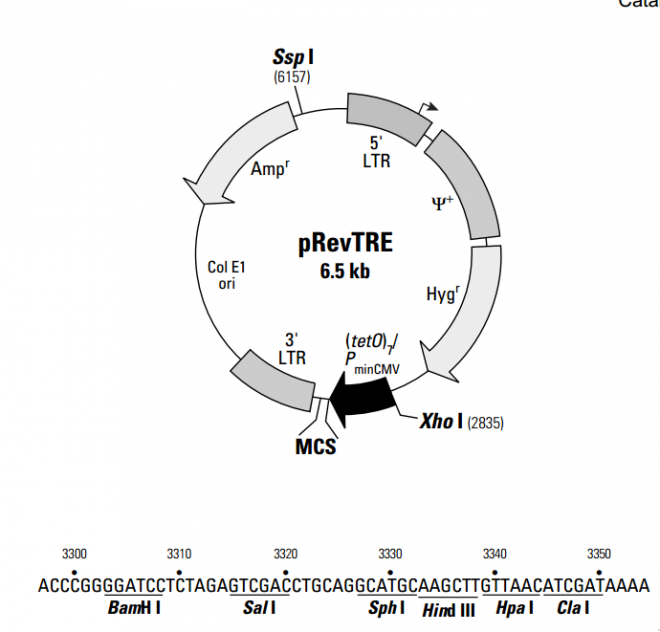pRevTR 载体
| 质粒类型: | 四环素调控系统 |
|---|---|
| 启动子: | CMV |
| 克隆方法: | 多克隆位点,限制性内切酶 |
| 载体大小: | 6487 bp (查看载体序列) |
| 载体抗性: | Ampicillin (氨苄青霉素) |
| 筛选标记: | Hygromycin (潮霉素) |
pRevTRE is a retroviral Tet response vector that expresses a gene of interest from the Tet-response element (TRE). This vector is derived from pLNCX, a retroviral vector created using elements of Moloney murine leukemia virus (MoMuLV) and Moloney murine sarcoma virus (MoMuSV) as described (1). The TRE contains seven direct repeats of the tetO operator sequence, upstream of a minimal CMV promoter, which can be bound by the tTA and rtTA transactivators. The 5' viral LTR controls expression of the transcript that contains Y+ (the extended viral packaging signal) and the hygromycin resistance (Hygr) gene for antibiotic selection in mammalian cells. The TRE is derived from vectors described previously (2, 3). pRevTRE also includes the E. coli Ampr gene for antibiotic selection in bacteria.
The complete RevTet-Off and RevTet-On Systems also include the control vector pRevTRE-Luc, which was constructed by cloning the firefly luciferase gene into the Hind III/Cla I sites in the MCS of pRevTRE.
载体应用
pRevTRE can be used to establish inducible Tet Systems via retrovirus-mediated gene transfer (4). Retroviral gene transfer allows the highly efficient transduction of virtually all dividing cell types. The RevTetTM Systems are also suitable for establishing transgenic animals. In combination with the pRevTet-On or pRevTet-Off regulatory vector, a gene of interest can be inducibly expressed at high levels in response to varying concentrations of tetracycline (Tc) or Tc derivatives such as doxycycline (Dox). tTA and rtTA bind to the Tet-response element (TRE) and activate transcription from the minimal promoter in the absence or presence of Dox, respectively. pRevTRE lacks the viral genes gag, pol, and env, which are supplied by the packaging cell line. It can be transfected into a high titer packaging cell line and thereby mediate production of infectious, replication-incompetent retroviral particles (1, 6–7). The transcript produced by the pRevTRE construct is recognized by the viral structural proteins expressed in a packaging cell line and packaged into infectious retroviral particles. Because the RNA transcript packaged in these particles does not contain the viral genes, it cannot replicate in the target cells that it infects.
The level of induction in cell populations infected with this vector depends on the efficiency of infection, the site of integration, and the titer of the virus. Viral supernatants with titers >105 cfu/ml should be produced to achieve high-level induction.


